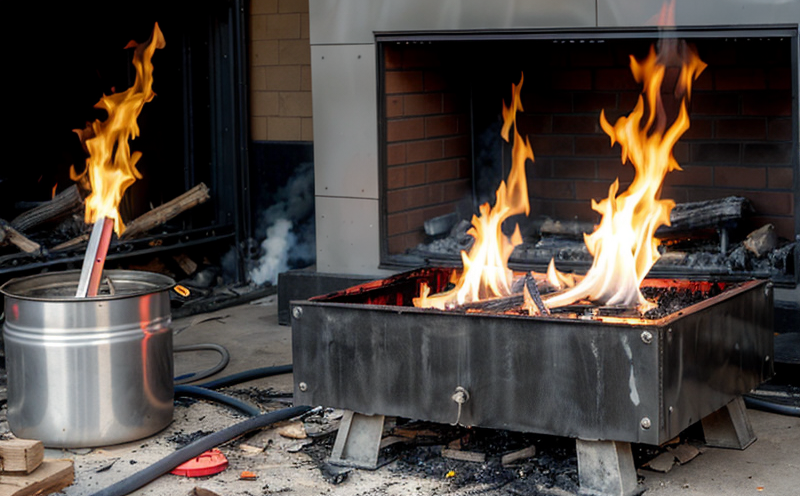ISO 4589 Oxygen Index Flammability Testing for Materials
The ISO 4589 oxygen index test is a critical procedure used to determine the lowest concentration of oxygen in air at which a material will sustain combustion. This method, based on international standard ISO 4589-1:2016, assesses both the flammability and flame retardancy properties of materials, especially those found in electronics, textiles, and other applications where fire safety is paramount.
The test involves placing a small sample of the material in an oxygen-rich atmosphere, gradually reducing the oxygen concentration until combustion can no longer be sustained. The oxygen index (OI) value is then determined as the percentage by volume of oxygen required for the flame to propagate. This value provides valuable insights into the fire resistance and potential flammability risks associated with a given material.
The ISO 4589 test is particularly important in industries where materials are exposed to high temperatures, such as electronics manufacturing, aviation, automotive, and building materials sectors. By ensuring that products meet stringent flammability standards, businesses can enhance the safety of their end-users while complying with regulatory requirements.
To perform this test correctly, precise control over the oxygen concentration is essential. The apparatus used for ISO 4589 testing typically includes an oxygen generator capable of producing different concentrations of air and a sample holder to secure the material during the test. The temperature and flow rate must also be carefully controlled to ensure accurate results.
For materials that are highly flammable or difficult to ignite, higher OI values indicate better flame resistance. Conversely, lower values suggest greater susceptibility to ignition under certain conditions. Understanding these values is crucial for optimizing product design and ensuring compliance with relevant safety standards such as IEC 60332 for electronic components.
The ISO 4589 test can also be used in conjunction with other methods, like the vertical burn test (ASTM E726), to provide a comprehensive evaluation of fire performance. By integrating these tests into a broader quality assurance framework, manufacturers can enhance their product reliability and safety.
Why Choose This Test
- Ensures compliance with international standards such as ISO 4589-1:2016
- Provides critical data on the flammability and flame retardancy of materials
- Helps in optimizing product design for enhanced safety performance
- Supports regulatory requirements, thereby reducing legal risks
- Promotes safer environments by identifying materials with poor fire resistance
- Assists in meeting industry-specific fire safety standards like IEC 60332
- Facilitates the development of flame-retardant compounds and technologies
- Enhances overall product quality through rigorous testing procedures
Environmental and Sustainability Contributions
The ISO 4589 oxygen index test plays a crucial role in promoting sustainability by helping manufacturers design products that are safer and more environmentally friendly. By ensuring that materials used in electronics, textiles, and other high-risk applications have adequate flame resistance, the test supports the reduction of fire hazards both during production and use.
Flame-retardant materials developed through ISO 4589 testing contribute to lower emissions of harmful gases when exposed to fire. This not only protects human health but also reduces the environmental impact associated with fire-related incidents. Furthermore, using this test in product development can lead to more sustainable manufacturing processes by minimizing waste and optimizing resource use.
By adhering to ISO 4589 standards, companies can contribute positively to global efforts aimed at reducing the carbon footprint of their products and operations. The data generated from these tests helps in making informed decisions that balance safety with environmental responsibility. This holistic approach ensures a safer and more sustainable future for all stakeholders involved.
Use Cases and Application Examples
| Application | Description |
|---|---|
| Electronics Manufacturing | Ensure that components like circuit boards, connectors, and wires meet stringent fire safety requirements. |
| Aerospace Industry | Test materials used in aircraft interiors to prevent cabin fires during emergencies. |
| Automotive Sector | Evaluate the flammability of seat fabrics, insulation materials, and other components to enhance vehicle safety. |
| Building Construction | Determine the fire resistance of insulation materials used in walls and ceilings for improved building safety. |
| Textile Industry | Assess the flammability risks associated with textile products like curtains, carpets, and upholstery. |
| Medical Devices | Evaluate components that might come into contact with flames during use to ensure patient safety. |
| Consumer Electronics | Test the flame retardancy of casings and internal components to prevent potential fire hazards in consumer products. |





